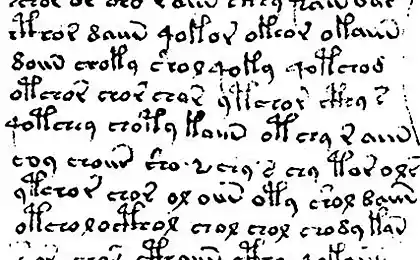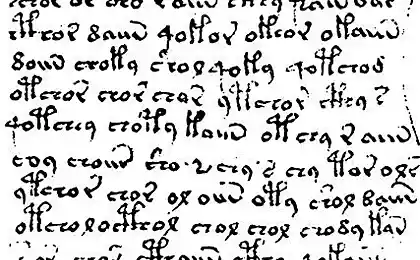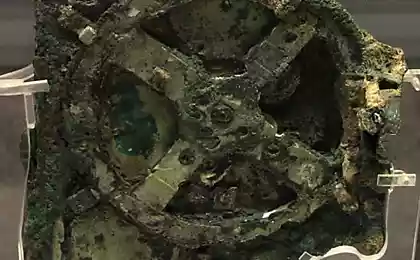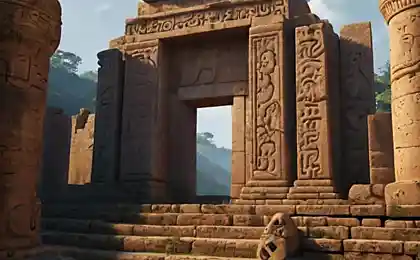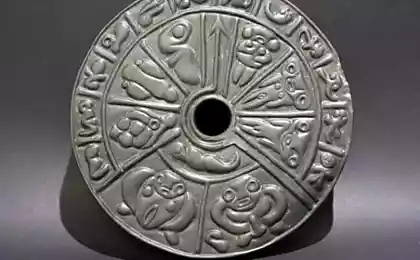720
Antikythera mechanism (8 ph)
"Lysippos stood up and left alone Thais and Indians, came the familiar path to his cell and returned with a large box of purple amaranth wood, bound in gold corners. Carefully putting it on the octagonal table, sculptor opened the latch. In light appeared strange mechanism - interlocking gears and levers of the various sizes. On the silver-plated rims were coated letters and punctuation.
Interested Indians leaned over the box.
- Apprentice Pythagoreans, Heraclitus of Pontus, close to Aristotle, discovered that the Gays ball spinning, like a top, around and that the axis of the gyroscope is tilted relative to the plane in which the planets and the sun go.
This machine is to calculate the motion of the planets, without which there can be no prediction of the future, nor the correct navigation. Here the mind asserts itself once, creating a machine, and then run a hand so memorable table, inscribed on the lid. Man freed from long calculations and can take a high reflections ».
As a child, reading a novel Ivan Efremov "Thais", I thought that the old "computer" - a fiction author. However, it turns out, such a device actually existed.
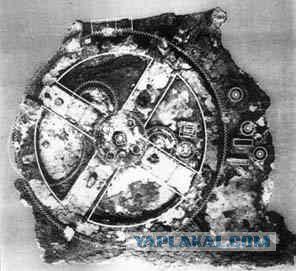
This extraordinary mechanism was found in 1901 (according to other sources, in 1900) among the sunken remains of about 80-50 years. BC. the ancient ship at a depth of 42 meters near the island of Antikythera in the Aegean Sea. The find is like a shapeless piece of stone with metal inclusions, was taken to the National Archaeological Museum in Athens, where it drew the attention of the museum archaeologist Valerios Stais. Clearing it of lime, it is to his surprise, found a complex mechanism such as time, with a lot of bronze gears, drive levers and measuring scales. Also parse some inscriptions made in Greek.

A fragment of the inscription.
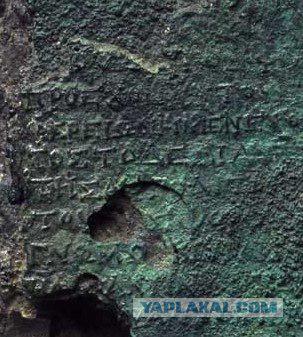
In this photo fragment Antikythera Mechanism, constant despite small resolution, graduated scales can be easily seen and Greek inscriptions.
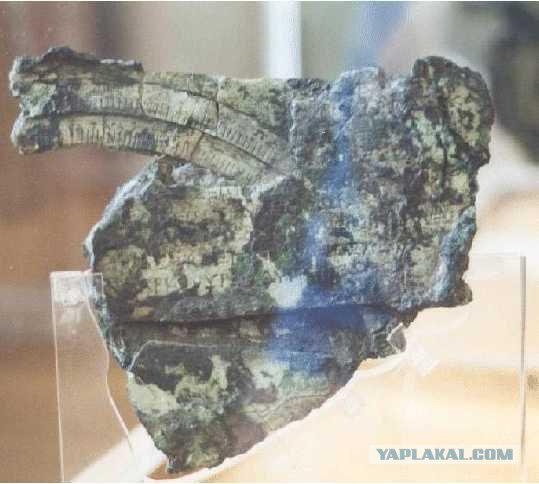
2000 years lain on the seabed, the mechanism has reached us in a very damaged state. The wooden frame on which, apparently, was attached device is completely dissolved. Metal parts were scattered and "caked" exposed to various chemical and physical influences.
Detail Antikythera Mechanism.

A link to a large image:
i243.photobucket.com/albums/ff124/s...07/IMG_1282.jpg
In 1903 in Athens, came the first official scientific publication with a description and photographs Antikythera Mechanism. *
* I. N. Σβoρώvoς, Το εv Αθήvαις Εθvικόv Μoυσείov [The National Museum in Athens] (Athens, 1903). The German edition: JN Svoronos, Das Athener National. Museum (Athens: Beck & Barth, 1908).
Reconstruct the device seemed almost hopeless case, and it has long been little known until it attracted the attention of prominent British science historian Derek de Solla Price (Derek J. de Solla Price). In 1959, Scientific American magazine published his article "Ancient Greek Computer" ** dedicated to the Antikythera Mechanism. Price found that this mechanism is a computing device designed for astronomical calculation, in particular for determining the position of the sun and moon relative to the fixed star.
** An Ancient Greek Computer, de Price, Derek Solla J., Scientific American, Volume 200, p.60-67 (1959)
i243.photobucket.com/albums/ff124/s...2007/p60-sm.jpg
i243.photobucket.com/albums/ff124/s...2007/p61-sm.jpg
i243.photobucket.com/albums/ff124/s...007/p62-sm2.jpg
i243.photobucket.com/albums/ff124/s...2007/p63-sm.jpg
i243.photobucket.com/albums/ff124/s...2007/p64-sm.jpg
i243.photobucket.com/albums/ff124/s...2007/p65-sm.jpg
i243.photobucket.com/albums/ff124/s...2007/p66-sm.jpg
i243.photobucket.com/albums/ff124/s...2007/p67-sm.jpg
Further investigation showed that the Antikythera Mechanism was used differential gear, which was believed until then, was not invented before the XVI century.
Using radiocarbon analysis (1971), paleographic study of inscriptions and other methods have been refined while creating Antikythera Mechanism - 150-100 years. BC. At this time, the Hellenistic astronomy is experiencing its heyday associated with names of scholars such as Hipparchus, and Posidonius.
Hipparchus of Nicea was the catalog of the starry sky, later used by Ptolemy, accurately describes the apparent motion of the moon, the sun and the five planets known at that time, the distance from the Earth to the Moon, and the size of the last, very close valid. Hipparchus theory allowed to predict lunar eclipses with an accuracy of one to two hours, and (with less accuracy) the sun.
Posidonius made a calculation of the distance from Earth to the Sun, amounting 5/8 of the actual (fantastic result, considering the then imperfect measuring instruments).
A century earlier did Aristarchus of Samos, the creator of the first in the history of the heliocentric system (1,800 years before Copernicus), and his younger contemporary of Archimedes, the greatest scientist of the ancient world and the forerunner of modern science.
The devices are comparable in complexity to the Antikythera Mechanism, in the monuments of antiquity are no longer there, although in ancient literature there are references to complex mechanisms (machines), Hero of Alexandria, Archimedes, Posidonius and others.
Cicero (106-43 BC.) In the dialogue "On state" reported that Archimedes built a planetarium - a hollow sphere with a rotating mechanism that allows to reproduce the movement of the moon, the sun and the five planets relative to the Earth in real time, "... on this ball of bronze alternated with the Sun Moon for the same number of turns, how many days it is replaced it at the sky ... "Cicero also mentions instrument" recently constructed by our friend Posidonius that each revolution reproduces the same motions of the sun, the moon, and five planets ».
However, these "spheres" were used to demonstrate the motion of celestial bodies, not astronomical calculations, as probably the Antikythera Mechanism.
In 2002, Michael Wright (Michael Wright), a specialist in mechanical devices of the Science Museum in London, offered his reconstruction of the Antikythera Mechanism. *** It has come to the conclusion that the mechanism could not only calculate the position of the sun and moon, and the five known in antiquity planets - Mercury, Venus, Mars, Jupiter and Saturn.
*** The Antikythera Mechanism reconsidered, Wright, MT, Interdisciplinary Science Reviews, 03/2007, Volume 32, Issue 1, p.27 - 43.
www3.imperial.ac.uk/pls/portallive/.../1/24853696.PDF
In subsequent years, a team of scientists from the UK and Greece produced a comprehensive study of Antikythera Mechanism with the latest technology (X-ray computed tomography, etc.). 95% failed to read the inscriptions on the mechanism (around 2000 characters), confirmed its astronomical purpose.
The same team has accomplished scientific reconstruction and established a working model Antikythera Mechanism. The results are set out in an article published in the journal Nature (2006). ****
**** Decoding the ancient Greek astronomical calculator known as the Antikythera Mechanism, Freeth, Tony, Bitsakis Yanis, Moussas Xenophon, Seiradakis John, Tselikas A., Mangou Helen, Zafeiropoulou Mary, Hadland R., Bate D., Ramsey Andrew, et al., Nature, 11/2006, Volume 444, p.587-591.
www.antikythera-mechanism.gr/system...0608_Nature.pdf
Additional notes:
www.antikythera-mechanism.gr/system...pplementary.pdf
It is assumed that the Antikythera mechanism, in addition to the above, could indicate the time of lunar and possibly solar eclipses, as well as serve as an astronomical calendar for the calculation of the Olympics. *****
***** Calendars with Olympiad display and eclipse prediction on the Antikythera Mechanism, Freeth, Tony, Jones Alexander R., Steele John M., and Bitsakis Yanis, Nature, 07/2008, Volume 454, p.614-617.
www.antikythera-mechanism.gr/system...8_submitted.pdf
Despite the hypothetical reconstruction due to poor preservation mechanism come down to us, we can conclude its extreme complexity, which had no analogues to modern times.
There is no doubt that this is a real "miracle of technology" created by ancient Greek scientists and Spreading our ideas about the possibilities of ancient science.
Antikythera Mechanism is currently on display at the National Archaeological Museum of Athens.
All. taken away sarmata.livejournal.com/
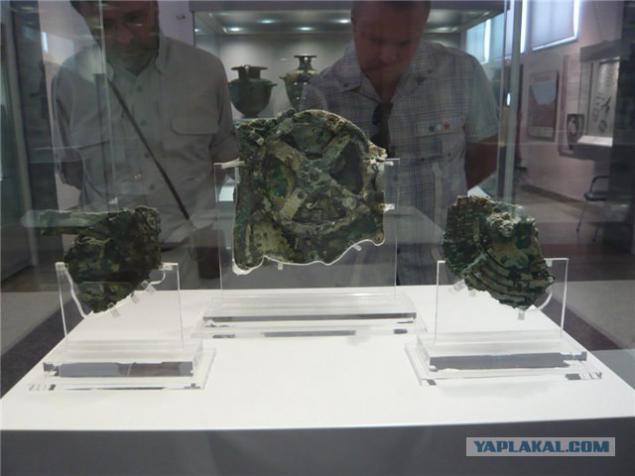
Source:
Interested Indians leaned over the box.
- Apprentice Pythagoreans, Heraclitus of Pontus, close to Aristotle, discovered that the Gays ball spinning, like a top, around and that the axis of the gyroscope is tilted relative to the plane in which the planets and the sun go.
This machine is to calculate the motion of the planets, without which there can be no prediction of the future, nor the correct navigation. Here the mind asserts itself once, creating a machine, and then run a hand so memorable table, inscribed on the lid. Man freed from long calculations and can take a high reflections ».
As a child, reading a novel Ivan Efremov "Thais", I thought that the old "computer" - a fiction author. However, it turns out, such a device actually existed.

This extraordinary mechanism was found in 1901 (according to other sources, in 1900) among the sunken remains of about 80-50 years. BC. the ancient ship at a depth of 42 meters near the island of Antikythera in the Aegean Sea. The find is like a shapeless piece of stone with metal inclusions, was taken to the National Archaeological Museum in Athens, where it drew the attention of the museum archaeologist Valerios Stais. Clearing it of lime, it is to his surprise, found a complex mechanism such as time, with a lot of bronze gears, drive levers and measuring scales. Also parse some inscriptions made in Greek.

A fragment of the inscription.

In this photo fragment Antikythera Mechanism, constant despite small resolution, graduated scales can be easily seen and Greek inscriptions.

2000 years lain on the seabed, the mechanism has reached us in a very damaged state. The wooden frame on which, apparently, was attached device is completely dissolved. Metal parts were scattered and "caked" exposed to various chemical and physical influences.
Detail Antikythera Mechanism.

A link to a large image:
i243.photobucket.com/albums/ff124/s...07/IMG_1282.jpg
In 1903 in Athens, came the first official scientific publication with a description and photographs Antikythera Mechanism. *
* I. N. Σβoρώvoς, Το εv Αθήvαις Εθvικόv Μoυσείov [The National Museum in Athens] (Athens, 1903). The German edition: JN Svoronos, Das Athener National. Museum (Athens: Beck & Barth, 1908).
Reconstruct the device seemed almost hopeless case, and it has long been little known until it attracted the attention of prominent British science historian Derek de Solla Price (Derek J. de Solla Price). In 1959, Scientific American magazine published his article "Ancient Greek Computer" ** dedicated to the Antikythera Mechanism. Price found that this mechanism is a computing device designed for astronomical calculation, in particular for determining the position of the sun and moon relative to the fixed star.
** An Ancient Greek Computer, de Price, Derek Solla J., Scientific American, Volume 200, p.60-67 (1959)
i243.photobucket.com/albums/ff124/s...2007/p60-sm.jpg
i243.photobucket.com/albums/ff124/s...2007/p61-sm.jpg
i243.photobucket.com/albums/ff124/s...007/p62-sm2.jpg
i243.photobucket.com/albums/ff124/s...2007/p63-sm.jpg
i243.photobucket.com/albums/ff124/s...2007/p64-sm.jpg
i243.photobucket.com/albums/ff124/s...2007/p65-sm.jpg
i243.photobucket.com/albums/ff124/s...2007/p66-sm.jpg
i243.photobucket.com/albums/ff124/s...2007/p67-sm.jpg
Further investigation showed that the Antikythera Mechanism was used differential gear, which was believed until then, was not invented before the XVI century.
Using radiocarbon analysis (1971), paleographic study of inscriptions and other methods have been refined while creating Antikythera Mechanism - 150-100 years. BC. At this time, the Hellenistic astronomy is experiencing its heyday associated with names of scholars such as Hipparchus, and Posidonius.
Hipparchus of Nicea was the catalog of the starry sky, later used by Ptolemy, accurately describes the apparent motion of the moon, the sun and the five planets known at that time, the distance from the Earth to the Moon, and the size of the last, very close valid. Hipparchus theory allowed to predict lunar eclipses with an accuracy of one to two hours, and (with less accuracy) the sun.
Posidonius made a calculation of the distance from Earth to the Sun, amounting 5/8 of the actual (fantastic result, considering the then imperfect measuring instruments).
A century earlier did Aristarchus of Samos, the creator of the first in the history of the heliocentric system (1,800 years before Copernicus), and his younger contemporary of Archimedes, the greatest scientist of the ancient world and the forerunner of modern science.
The devices are comparable in complexity to the Antikythera Mechanism, in the monuments of antiquity are no longer there, although in ancient literature there are references to complex mechanisms (machines), Hero of Alexandria, Archimedes, Posidonius and others.
Cicero (106-43 BC.) In the dialogue "On state" reported that Archimedes built a planetarium - a hollow sphere with a rotating mechanism that allows to reproduce the movement of the moon, the sun and the five planets relative to the Earth in real time, "... on this ball of bronze alternated with the Sun Moon for the same number of turns, how many days it is replaced it at the sky ... "Cicero also mentions instrument" recently constructed by our friend Posidonius that each revolution reproduces the same motions of the sun, the moon, and five planets ».
However, these "spheres" were used to demonstrate the motion of celestial bodies, not astronomical calculations, as probably the Antikythera Mechanism.
In 2002, Michael Wright (Michael Wright), a specialist in mechanical devices of the Science Museum in London, offered his reconstruction of the Antikythera Mechanism. *** It has come to the conclusion that the mechanism could not only calculate the position of the sun and moon, and the five known in antiquity planets - Mercury, Venus, Mars, Jupiter and Saturn.
*** The Antikythera Mechanism reconsidered, Wright, MT, Interdisciplinary Science Reviews, 03/2007, Volume 32, Issue 1, p.27 - 43.
www3.imperial.ac.uk/pls/portallive/.../1/24853696.PDF
In subsequent years, a team of scientists from the UK and Greece produced a comprehensive study of Antikythera Mechanism with the latest technology (X-ray computed tomography, etc.). 95% failed to read the inscriptions on the mechanism (around 2000 characters), confirmed its astronomical purpose.
The same team has accomplished scientific reconstruction and established a working model Antikythera Mechanism. The results are set out in an article published in the journal Nature (2006). ****
**** Decoding the ancient Greek astronomical calculator known as the Antikythera Mechanism, Freeth, Tony, Bitsakis Yanis, Moussas Xenophon, Seiradakis John, Tselikas A., Mangou Helen, Zafeiropoulou Mary, Hadland R., Bate D., Ramsey Andrew, et al., Nature, 11/2006, Volume 444, p.587-591.
www.antikythera-mechanism.gr/system...0608_Nature.pdf
Additional notes:
www.antikythera-mechanism.gr/system...pplementary.pdf
It is assumed that the Antikythera mechanism, in addition to the above, could indicate the time of lunar and possibly solar eclipses, as well as serve as an astronomical calendar for the calculation of the Olympics. *****
***** Calendars with Olympiad display and eclipse prediction on the Antikythera Mechanism, Freeth, Tony, Jones Alexander R., Steele John M., and Bitsakis Yanis, Nature, 07/2008, Volume 454, p.614-617.
www.antikythera-mechanism.gr/system...8_submitted.pdf
Despite the hypothetical reconstruction due to poor preservation mechanism come down to us, we can conclude its extreme complexity, which had no analogues to modern times.
There is no doubt that this is a real "miracle of technology" created by ancient Greek scientists and Spreading our ideas about the possibilities of ancient science.
Antikythera Mechanism is currently on display at the National Archaeological Museum of Athens.
All. taken away sarmata.livejournal.com/

Source:





